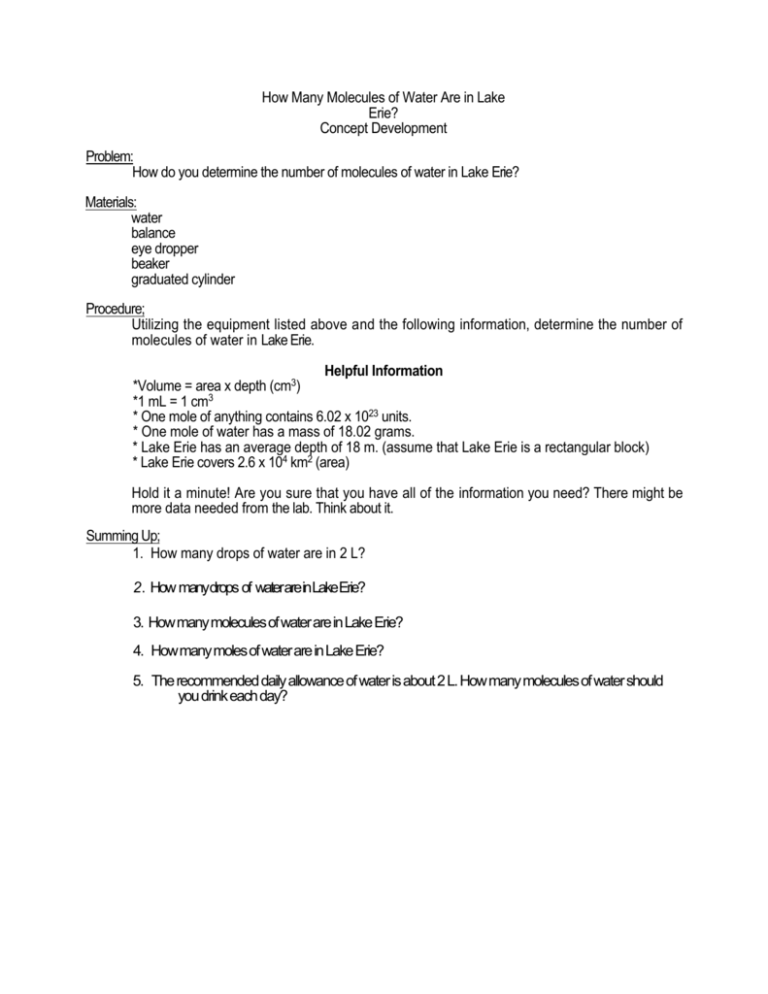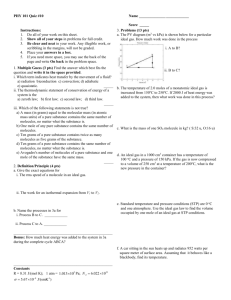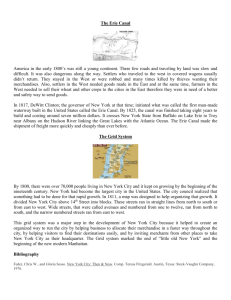How Many Molecules of Water Are in Lake Erie? Concept
advertisement

How Many Molecules of Water Are in Lake Erie? Concept Development Problem: How do you determine the number of molecules of water in Lake Erie? Materials: water balance eye dropper beaker graduated cylinder Procedure; Utilizing the equipment listed above and the following information, determine the number of molecules of water in Lake Erie. Helpful Information *Volume = area x depth (cm3) *1 mL = 1 cm3 * One mole of anything contains 6.02 x 1023 units. * One mole of water has a mass of 18.02 grams. * Lake Erie has an average depth of 18 m. (assume that Lake Erie is a rectangular block) * Lake Erie covers 2.6 x 104 km2 (area) Hold it a minute! Are you sure that you have all of the information you need? There might be more data needed from the lab. Think about it. Summing Up; 1. How many drops of water are in 2 L? 2. How manydrops of waterareinLakeErie? 3. How many molecules of water are in Lake Erie? 4. How many moles of water are in Lake Erie? 5. The recommended daily allowance of water is about 2 L. How many molecules of water should you drink each day? Teacher Notes How Many Molecules of Water Are in Lake Erie? Lab Setup Calculations Reliability Interest Lab time Process skills Concept Development easy moderate easy moderate excellent good excellent good -1 class 1 class Interpreting Data difficult difficult fair fair +1 class Experimenting Objective: By completing this activity students will be able to determine the number of water molecules in Lake Erie. They will utilize the factor-label method to make difficult calculations by breaking a problem down into intermediate steps. Materials: water balance eye dropper beaker graduated cylinder Teaching Strategies; Students will first need to determine experimentally the number of drops of water in 1 mL, but let them figure this out on their own! Drops should be of uniform size. With the use of a balance, students should then determine that 1 mL of water has a mass of approximately 1 g. If needed, review the factorlabel method in making calculations. For simplicity, tell students to assume that Lake Erie is essentially a rectangular block so they can successfully calculate the volume. Sample Data: 1 mL of water = 20 drops 1 mL of water = 1 gram Summing Up: 1. Number of drops in 2 L: 2 L x 1000 mL x 20 drops 1 L 1 mL 2. = 40,000 drops Number of drops of water in Lake Erie: 2. 6 x 104 km2 x 1 , 0 0 0 , 0 0 0 m2 x 10,000 cm2 = 2 . 6 x 1014 cm2 area 1 km2 1 m2 18 m x 100 cm = 1,800 cm (depth) 1m vol = area x depth 2.6 x 1014 cm2 x 1,800 cm = 4.68 x 1017 cm3 4.68 X 1017 cm3 x 1 mL = 4.68 X 1017 mL 1 cm3 4.68 x 1017 mL x 20 drops = 9.36 x 1018 drops of water 1 mL 3. Molecules of water in Lake Erie: 4.68 x 1017 mL x 1 g x 1 mole x 6.02 x 1023 molecules 1 mL 18.02 g 1 mole 1.56 x 1040 molecules 4. Moles of water in Lake Erie: ____1 mole_______ x 1.56 x 1040 molecules = 6.02 x 1023 molecules 2.59 X 1016 moles 5. Molecules of water needed to meet daily requirement: 2 L x 1000 mL x 1 g x 1 mole x 6.02 x 1023 molecules = 1 L 1 mL 18.02 g 1 mole 6.68 x 1025 molecules Adapted txom an id«« d«aorlb*d in Th« 8ci«no« T««oh«r.








